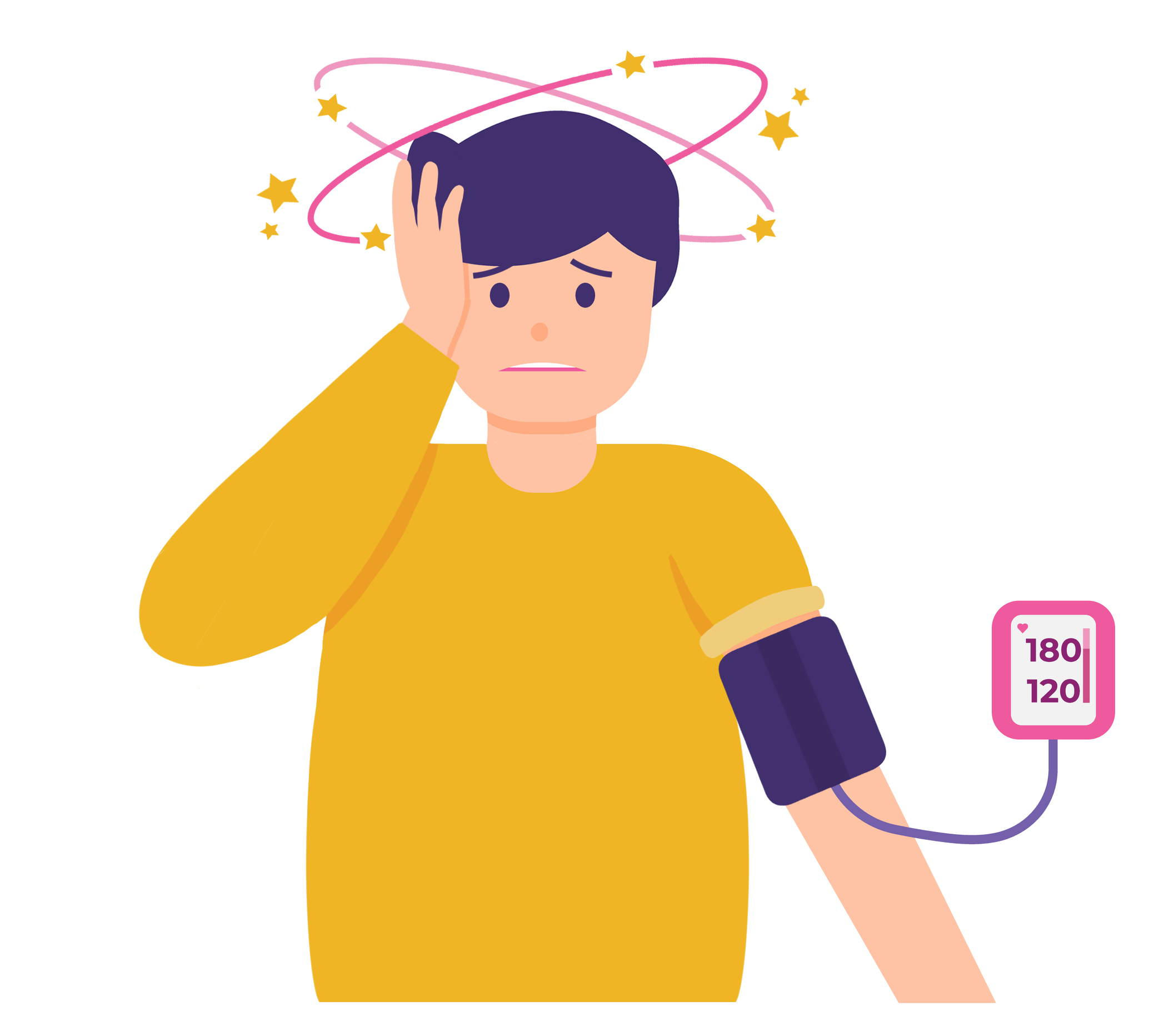There is some evidence of a positive association between high BP and dizziness, but contradicting results have also been shown.1-4 While some patients report mild transient symptoms such as dizziness, hypertension is largely asymptomatic.5-8 The World Health Organization (WHO) states that most people with hypertension have no symptoms.7 However, they follow this statement with the acknowledgement that sometimes people can have symptoms, including dizziness. The WHO also states that these symptoms cannot be relied on to identify people with hypertension.
A 1972 analysis of data from the United States Health Examination Survey from 1960 to 1962 (n=6,672) examined the relationship between BP and self-reported symptoms including headache, nosebleed, tinnitus, dizziness, and fainting.11 There was no correlation between elevated BP and headache, nosebleeds, or tinnitus. Dizziness was found slightly more often in people with a high diastolic pressure (DBP) (reported by 9.4% of those with DBP<90 mmHg vs 11.5% for DBP≥100 mmHg), and fainting occurred less often in people with higher blood pressure (reported by 24.4% of those with DBP<90 mmHg vs 15.8% for DBP≥100 mmHg; 24.4% for systolic BP <140 mmHg vs 16.5% for ≥160 mmHg).2
A 1982 study of 1,771 adults with untreated hypertension examined symptom prevalence in relation to blood pressure levels.9 Mean supine systolic BP (SBP) was 159±28 mmHg and DBP was 94±16 mmHg, and the mean duration of disease was seven years. The most reported symptoms were headache (40.5%), anxiety (30.7%), palpitation (28.5%), emotivity (27.7%), dizziness (20.8%), nocturia (20.4%), and tinnitus (13.8%). After adjusting for age, the authors found no correlation between BP levels and headaches, palpitation, dizziness, or tinnitus.3 In men, after age adjustment, only nocturia increased significantly (p<0.01) with systolic BP. In women, no significant correlations were found for the prevalence of symptoms and BP.
A 1997 longitudinal study surveyed 6,289 patients being treated for hypertension. Among those with well-controlled BP (<160/95 mmHg), 49% experienced at least one side effect compared to 61% of patients with poorly controlled BP.9 Symptoms (including headache, dizziness, tinnitus, thirst, gingivitis, taste loss, edema, rash, fatigue, hot flush, cough, shortness of breath, palpitations, nausea, indigestion, constipation, pollakiuria, cold extremities, decreased libido, somnolence, insomnia, depression, anxiety, nightmares, and decreased attention span) were reported significantly more frequently by patients with poorly controlled BP (p<0.05) with no significant between-group differences based on medication. Dizziness specifically was reported in 7.3% of patients taking calcium channel blockers (CCBs), 8.6% of those taking angiotensin-converting enzyme (ACE) inhibitors, 5.9% for beta blockers, and 6.0% for diuretics.
A 2005 prospective observational study examined the relationship between cardiopulmonary and neurological symptoms reported by emergency department patients with elevated BP (≥140/90 mmHg). Of the 285 patients interviewed, 62.8% reported hypertension-associated symptoms, including chest pain (26.0%), shortness of breath (36.5%), headache (32.3%), dizziness (26.0%), nosebleed (4.9%), blurred vision (20.7%), or focal neurological deficit (1.1%). There was no significant relationship between symptom prevalence and severity of BP elevation.10
A 2008 cross-sectional study examined 59,448 participants of which 55,165 were diagnosed with hypertension, 4,283 had other diagnoses, and 1,399 were normotensive controls.4 Up to 52.9% of untreated hypertensive participants with severe hypertension (≥180/110 mmHg) and up to 56.7% of treated hypertensive participants reported symptoms attributed to hypertension. Dizziness (19.6% vs 13.6%) and headaches (17.0% vs 7.4%) were significantly more likely (p<0.0001) in the untreated participants with hypertension compared to normotensive participants.
Antihypertensive Medication
Some perceived side effects from hypertension may be associated with medications used to treat hypertension rather than the condition itself.11 For example, dizziness is a common side effect of ACE inhibitors, occurring in 1.3-4.3% of those who take them according to manufacturer drug trials. According to a 2003 meta-analysis of 38 published randomized, double blind, placebo-controlled trials, dizziness occurs in 2.8% of those taking an ACE inhibitor compared to 2.2% placebo.
Some studies examined the prevalence of symptoms between treated and untreated patients with hypertension. One such study found that dizziness was more likely to occur in treated patients (22.19%, n=11,643) compared to untreated hypertensive patients (19.55%, n=421), suggesting that the symptom may be related to the antihypertensive medication rather than the blood pressure itself.4
Secondary Hypertension
Hypertension can sometimes be caused by an underlying condition which can also be the cause of symptoms that could be misattributed to hypertension.12 Causes of secondary high blood pressure include renal disease, primary aldosteronism, obstructive sleep apnea, use of drugs or alcohol, pheochromocytoma, Cushing’s syndrome, thyroid conditions, aortic coarctation, acromegaly, congenital adrenal hyperplasia, and mineralocorticoid excess syndromes.
References
- Kottke TE, Tuomilehto J, Puska P, Salonen JT. The relationship of symptoms and blood pressure in a population sample. International Journal of Epidemiology. 1979;8(4):355-359.
- Weiss NS. Relation of high blood pressure to headache, epistaxis, and selected other symptoms: The United States Health Examination Survey of Adults. New England Journal of Medicine. 1972;287(13):631-633.
- Chatellier G, Degoulet P, Devries C, Vu H-A, Plouin P-F, Menard J. Symptom prevalence in hypertensive patients. European Heart Journal. 1982;3(suppl_C):45-52.
- Middeke M, Lemmer B, Schaaf B, Eckes L. Prevalence of hypertension-attributed symptoms in routine clinical practice: a general practitioners-based study. Journal of Human Hypertension. 2008/04/01 2008;22(4):252-258. doi:10.1038/sj.jhh.1002305
- Ohler WR. The signs and symptoms of hypertension. American Heart Journal. 1927;2(6):609-612.
- Page IH. Hypertension: a symptomless but dangerous disease. The New England Journal of Medicine. 1972;287(13):665-666.
- Organization WH. A global brief on hypertension: silent killer, global public health crisis: World Health Day 2013. 2013;
- Siu AL, Force* UPST. Screening for high blood pressure in adults: US Preventive Services Task Force recommendation statement. Annals of internal medicine. 2015;163(10):778-786.
- Toyoshima H, Takahashi K, Akera T. The impact of side effects on hypertension management: a Japanese survey. Clinical therapeutics. 1997;19(6):1458-1469.
- Karras DJ, Ufberg JW, Harrigan RA, Wald DA, Botros MS, McNamara RM. Lack of relationship between hypertension-associated symptoms and blood pressure in hypertensive ED patients. The American journal of emergency medicine. 2005;23(2):106-110.
- Law M, Wald N, Morris J. Lowering blood pressure to prevent myocardial infarction and stroke: a new preventive strategy. Health technology assessment (Winchester, England). 2003;7(31):1-94.
- Whelton PK, Carey RM, Aronow WS. Acc/aha/aapa/abc/acpm/ags/APhA/ASH/ASPC/nma/pcna guideline for the prevention, Detection, evaluation, and management of high blood pressure in adults: a Report of the American College of Cardiology/American heart Association. Task force on clinical practice guidelines//J. Am. Coll. Cardiol.-2017.-Nov 13. Почки. 2018;7(1):68-74.


.png)
